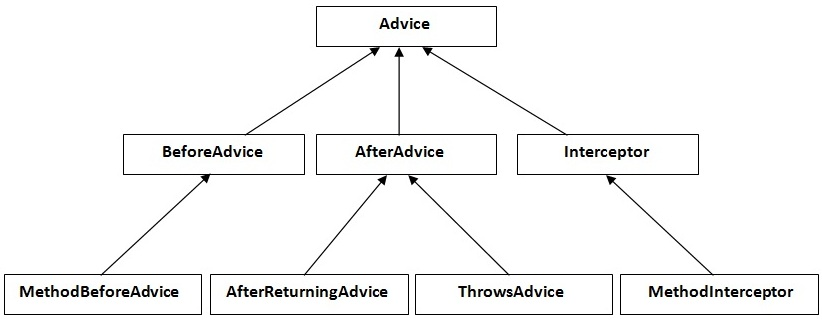tags : [Spring Framework
Aspect-oriented programming (AOP) is an approach to programming that allows global properties of a program to determine how it is compiled into an executable program. AOP can be used with object-oriented programming ( OOP ).
AOP breaks the program logic into distinct parts (called concerns). It is used to increase modularity by cross-cutting concerns.
A cross-cutting concern is a concern that can affect the whole application and should be centralized in one location in code as possible, such as
- transaction management,
- authentication,
- logging,
- user input validations,
- security etc.
AOP Concepts and Terminology
- Join point
- Advice
- Pointcut
- Introduction
- Target Object
- Aspect
- Interceptor
- AOP Proxy
- Weaving
Join point
Join point is any point in your program such as method execution, exception handling, field access etc. Spring supports only method execution join point.
Advice
Advice represents an action taken by an aspect at a particular join point. There are different types of advices:
- Before Advice: it executes before a join point.
- After Returning Advice: it executes after a joint point completes normally.
- After Throwing Advice: it executes if method exits by throwing an exception.
- After (finally) Advice: it executes after a join point regardless of join point exit whether normally or exceptional return.
- Around Advice: It executes before and after a join point.

- MethodBeforeAdvice interface extends the BeforeAdvice interface.
- AfterReturningAdvice interface extends the AfterAdvice interface.
- ThrowsAdvice interface extends the AfterAdvice interface.
- MethodInterceptor interface extends the Interceptor interface. It is used in around advice.
Pointcut
It is an expression language of AOP that matches join points.
@Pointcut("execution(* Operation.*(..))")
private void doSomething() {}
The name of the pointcut expression is doSomething().
It will be applied on all the methods of Operation class regardless of return type.@Pointcut("execution(public * *(..))")
It will be applied on all the public methods.@Pointcut("execution(public Employee.set*(..))")
It will be applied on all the public setter methods of Employee class.@Pointcut("execution(int Operation.*(..))")
It will be applied on all the methods of Operation class that returns int value.Introduction
It means introduction of additional method and fields for a type. It allows you to introduce new interface to any advised object.
Target Object
It is the object i.e. being advised by one or more aspects. It is also known as proxied object in spring because Spring AOP is implemented using runtime proxies.
Aspect
It is a class that contains advices, joinpoints etc.
Interceptor
It is an aspect that contains only one advice.
AOP Proxy
It is used to implement aspect contracts, created by AOP framework. It will be a JDK dynamic proxy or CGLIB proxy in spring framework.
Weaving
It is the process of linking aspect with other application types or objects to create an advised object. Weaving can be done at compile time, load time or runtime. Spring AOP performs weaving at runtime.
AOP Implementations
AOP implementations are provided by:
- AspectJ
- Spring AOP
- JBoss AOP
Spring AOP:
package com.javatpoint;
public class A {
public void m(){
System.out.println("actual business logic");
}
}import java.lang.reflect.Method;
import org.springframework.aop.MethodBeforeAdvice;
public class BeforeAdvisor implements MethodBeforeAdvice{
@Override
public void before(Method method, Object[] args, Object target)throws Throwable {
System.out.println("additional concern before actual logic");
}
} public class Test {
public static void main(String[] args) {
Resource r=new ClassPathResource("applicationContext.xml");
BeanFactory factory=new XmlBeanFactory(r);
A a=factory.getBean("proxy",A.class);
a.m();
}
}
//output
additional concern before actual logic
actual business logicAspectJ
There are two ways to use Spring AOP AspectJ implementation:
-
By annotation.
-
By xml configuration.
-
@Aspect declares the class as aspect.
-
@Pointcut declares the pointcut expression.
-
@Before declares the before advice. It is applied before calling the actual method.
-
@After declares the after advice. It is applied after calling the actual method and before returning result.
-
@AfterReturning declares the after returning advice. It is applied after calling the actual method and before returning result. But you can get the result value in the advice.
-
@Around declares the around advice. It is applied before and after calling the actual method.
-
@AfterThrowing declares the throws advice. It is applied if actual method throws exception.
public class Operation{
public void msg(){System.out.println("msg method invoked");}
public int m(){System.out.println("m method invoked");return 2;}
public int k(){System.out.println("k method invoked");return 3;}
} @Aspect
public class TrackOperation{
@Pointcut("execution(* Operation.*(..))")
public void k(){}//pointcut name
@Before("k()")//applying pointcut on before advice
public void myadvice(JoinPoint jp)//it is advice (before advice)
{
System.out.println("additional concern");
}
} public class Test{
public static void main(String[] args){
ApplicationContext context = new ClassPathXmlApplicationContext("applicationContext.xml");
Operation e = (Operation) context.getBean("opBean");
System.out.println("calling msg...");
e.msg();
System.out.println("calling m...");
e.m();
System.out.println("calling k...");
e.k();
}
}
//Output
1. calling msg...
2. additional concern
3. msg() method invoked
4. calling m...
5. additional concern
6. m() method invoked
7. calling k...
8. additional concern
9. k() method invoked-
By XML :
-
aop:before It is applied before calling the actual business logic method.
-
aop:after It is applied after calling the actual business logic method.
-
aop:after-returning it is applied after calling the actual business logic method. It can be used to intercept the return value in advice.
-
aop:around It is applied before and after calling the actual business logic method.
-
aop:after-throwing It is applied if actual business logic method throws exception.
<aop:aspectj-autoproxy />
<bean id="opBean" class="com.javatpoint.Operation"> </bean>
<bean id="trackAspect" class="com.javatpoint.TrackOperation"></bean>
<aop:config>
<aop:aspect id="myaspect" ref="trackAspect" >
<!-- @Before -->
<aop:pointcut id="pointCutBefore" expression="execution(* com.javatpoint.Operation.*(..))" />
<aop:before method="myadvice" pointcut-ref="pointCutBefore" />
</aop:aspect>
</aop:config>